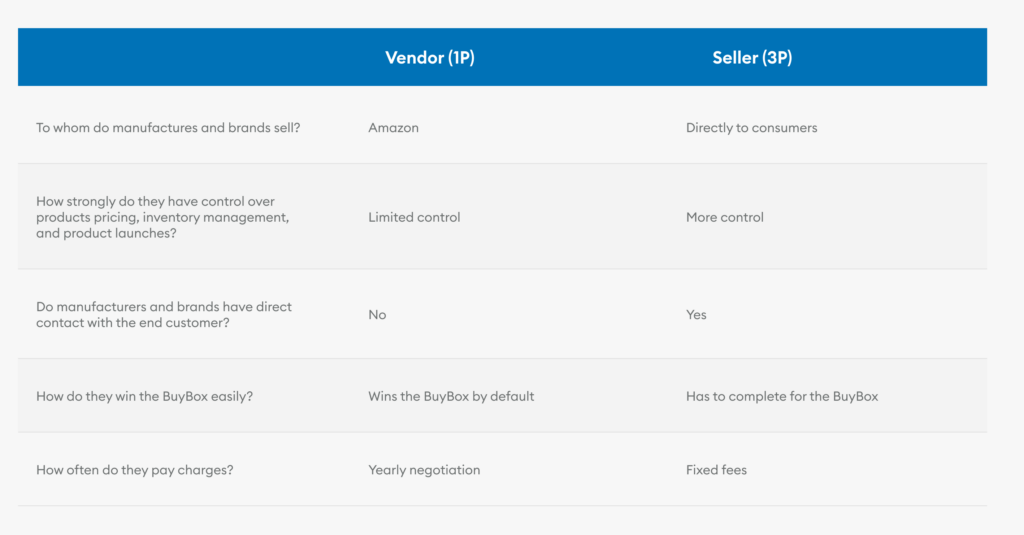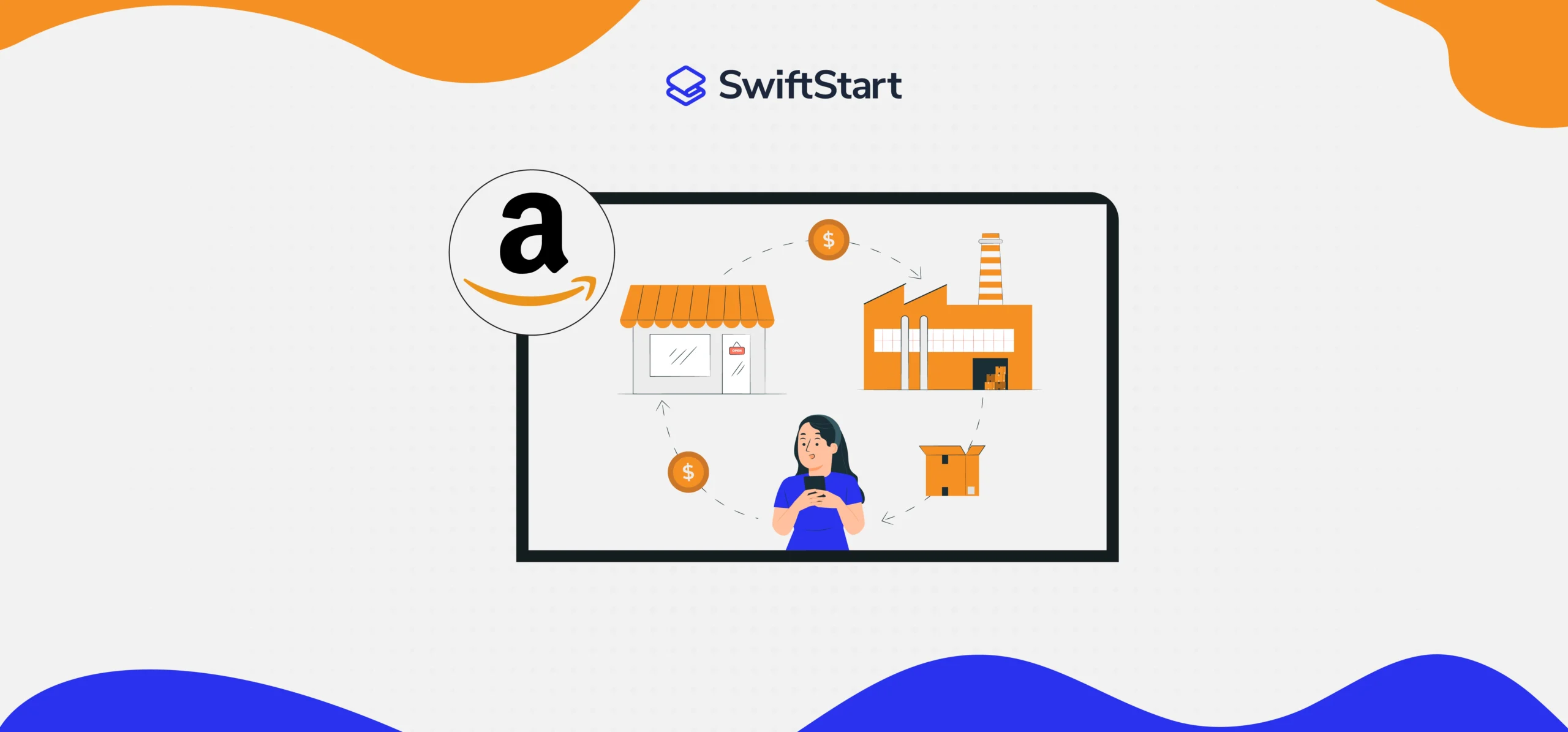SwiftStart launched Fomin during the height of the pandemic. The brand is now expanding its product lines after tripling revenue.

Complex vendor negotiations, lower control over products, higher costs, and tight pricing algorithms have caused several brands to question the 1P Vendor Model. Such a situation poses a serious question:
Could transitioning from the 1P (Vendor Central) to 3P (Seller Central) be the solution for businesses?
The move to Seller Central could be for you too, if the 1P model has made an impact on your business that makes it hard for companies to run their operations profitably. And in this game, you’re not alone to face similar challenges and thinking about moving to the 3P model. In fact, third-party sellers on Amazon contribute to 56% of total Amazon sales which shows you could be the one too.
Apparently, the major cause behind this transition is the skyrocketing costs linked to the 1P business model. But there’s much more than this.
So if you’re not sure whether to adopt the 3P model or still stick with the 1P model, read this article to explore why you should immediately switch to Seller Central. Also, you will explore how and when you must move to Seller Central.
If we talk broadly here, there are three major reasons why you must move from the 1P to 3P model on Amazon.
The primary reason for frustration with the 1P Vendor model originates from its complexity, which makes implementation costly or difficult.
In Vendor Central, vendors are exposed to a case system or self-service tools that eliminate the need to manually handle the Amazon account. Also, there are Joint Business Plans and annual vendor negotiations that do not bring much value to vendors in return.
With the rise in popularity of 3P selling, Amazon has been working to improve this platform. They offer features such as A+ content and Brand Registry that were previously only accessible through direct sales with limited availability - but not anymore!
Brands on Amazon switching from a Vendor Central to Seller Central present a real opportunity to save cost because they only have to pay a fixed fee.

There are a few different reasons why someone might want to switch to Seller Central. Here's how you can tell which one is right for your business!
If you don't have access to dedicated staff and rely only on case management in Vendor Central, you're being managed by Amazon's vendor success program (VSP). VSP is a program that provides support for non-technical issues between vendors and Amazon.
This includes things like resolving inquiries about orders, payments, or shipping status through their marketplace site.
VSP managers are the people who make sure that a company's brands with low revenue figures remain afloat and running. This means constantly monitoring feedback from vendors, staying in touch by phone or email when necessary but never meeting face-to-face unless absolutely necessary. And it is a common practice that they handle hundreds of vendor accounts making it difficult for brands to get dedicated support when required.
On the other hand, The Amazon 3P program is great for sellers who want a more hands-on approach to managing their businesses. They can speak directly with an account manager on the phone and receive well-documented instructions about self-serving options in order to manage inventory, marketing campaigns, etc., which will make it easier for them than ever before!

The 1P business model is all about balance. You need to invest more each year in order to grow your company's sales figures, but it will only return those increases if you maintain a healthy relationship with the Vendors Manager who matches these investments by providing better service than any other vendor out there can offer!
There is a lot that goes into providing quality service for customers, but the cost it takes to keep up with chargebacks and price variances just become too much.
Negotiation can be an option for you as a vendor, but it's often a lengthy and complicated process. Your company's trade terms with the buyer are likely to be set in stone so there is little room to negotiate on them. And consequently, chances are that your Vendor Manager is not going to accept it easily.
One way to avoid the headache of unsustainable selection is by moving it into 3P/FBA, which ensures you'll be able to continue selling all of the items in your portfolio directly to customers while working with your Amazon manager.
On the other hand, The Amazon 3P program is great for sellers who want a more hands-on approach to managing their businesses. They can speak directly with an account manager on the phone and receive well-documented instructions about self-serving options in order to manage inventory, marketing campaigns, etc., which will make it easier for them than ever before!
Incentives can be the biggest culprit when it comes to price variation. The incentive structure of your distribution channel strategy might need some work before Amazon starts eating away your profits.
The reason is that they're eroding prices, but one of the main reasons could be that there is something wrong with how you set up these deals and promotions between customers/distributors (like an imbalance).
In such a condition, switching to 3P is a good option for you in order to take control of your prices.
With the rise in competition, many brands have turned to using Seller Central as an additional account. This is because of the fact that if anything drastic happens like higher fees or margin pressure on Amazon’s side then they can move their business back without any problems and still continue selling through this marketplace platform!
Many brands are still very much in the early stages when it comes to selling on Amazon. They use a 3P account as a way station before moving onto more traditional models like using their own website and shipping products through UPS or FedEx.
However, some may not want this model because they need time for team-building purposes. They will keep following both approaches until their team has been trained to the extent that everything works together seamlessly (and also provides additional security).

It's important to follow the guidelines and terms set in place by Amazon when making a transition from Vendor Central to Seller Central. This can help avoid any legal issues down the road with their business model.!
Here are the steps that you need to follow in order to switch from Vendor Central to Seller Central:
There are two options and you can choose either of them if you’re willing to become a 3P seller.
Amazon is a powerful force to be reckoned with in eCommerce. The company's hybrid approach enables brands like yours, who want control over pricing but also need access to Amazon’s infrastructure for fulfillment or marketing on key products.
In order to maximize the potential of Amazon, more and more brands are going with a hybrid approach. They use both first-party (1P) selling as well as third-party sellers (1P) who also sell on Amazon from their own accounts.
This means that over half of brands are selling on Amazon with both first-party and third-party commissions. This hybrid approach has been gaining momentum, as it allows them to explore all avenues for success in different markets without having anyone’s strategy dominating their entire business model.
Despite several benefits, every brand doesn’t seem to be equally interested in Vendor Central. So for them, the other option is a hard switch.
It is important for brands to transition from the 1P model to 3P effectively because a hard change also risks shutting down revenue streams if not planned carefully.
When it comes to strategically engaging with customers, sometimes a company needs help from outside sources. This can range anywhere between hiring consultants or agencies that are specialized in certain fields. This will bridge any knowledge gaps you might have so you're not left behind because of the lack of understanding when trying new things!
A hard switch is an excellent option for brands that:
For these companies, Amazon can be both intimidating as well daunting at first glance because it's not just about selling on one channel. You also have to manage inventory locally rather than shipping outbound packages from fulfillment centers which means having more work ahead.
There are a number of challenges that come with moving to Seller Central. The following is a list of the most common hurdles brands face when they're considering leaving the 1P Vendor Model:
Amazon has introduced its first-party business to ensure the availability of critical products at low prices. Leaving Vendor Central poses a direct threat to this model, which is why many vendors are staying put in order not to lose access or be pushed out by Amazon's own marketplace strategies!
Amazon's marketplace allows sellers to compete with their own distribution partners on the company’s website. This means if you want your products stocked in store and available for purchase by customers directly through Amazon, then it will be difficult without being prioritized as a vendor within Buy Boxes.
Amazon's policies are designed to provide customers with an exceptional experience. If third-party sellers fail to meet these requirements, they risk having their accounts deactivated and losing all revenue streams on Amazon.

Amazon has expanded its advertising service to include a full funnel of opportunities. Brands can now advertise on and off Amazon’s website, making it easier than ever for them to get noticed in the market! However with so many brands switching over there's an arms race when it comes down to how you stand out amongst others vying for attention. Stay ahead by adding some innovation into your campaign strategy!
Swiftstart is an AI technology company that specializes in the optimization of sponsored ads on Amazon. It has a team dedicated to leveraging your brand across all websites and it can do this because of its real time capabilities, giving you maximum potential for increasing brand awareness.
There are several ways to sell on Amazon. In this post, you have learned about transitioning from 1P (vendor seller) to 3P (seller central). By making this transition, you'll have more control over your inventory and sales channels.
As many brands are switching to the 3P model, they must know that this transition requires a different set of skills and knowledge from what their teams already have.
As Seller Central does not offer fully-integrated supplier systems, brands need to manage one on their own with all the necessary features to track different activities.
A well-organized Amazon Product Detail Page (PDP) gives shoppers the best and most important details about a product, no matter how many sellers sell it or where they buy it from. Key Highlights Why We Wrote This? We write this content so that Amazon sellers know the details of an Amazon product page and optimize […]
)
In online selling, Amazon's Order Defect Rate is a key metric that affects your performance rate. Therefore, all Amazon sellers need to pay attention to it. Highlights Why We Wrote This? The content aims to inform Amazon sellers about the significance of the Amazon Order Defect Rate as a key metric for assessing their performance […]
)
If you want to improve your vendor margin on Amazon, it's likely that the first place where things will change is with cost prices. However, it’s a common misconception that Amazon will simply pass on any cost increases to the end customer. In fact, they have many strategies in place to manage their margins and […]
)
Amazon is a powerful sales channel that you can't afford to ignore if you want to grow your brand. There are several things you must know before diving into this venture, especially if you're new. However, there are some mistakes that many brands make on Amazon that can hurt their business. In this post, we'll […]
)
The beginning of the customer journey is an important phase for retailers and marketers. They focus their efforts on making sure that shoppers know about products. Through their brand awareness campaigns, they try to educate their target audience and convince them that their products are fulfilling their desires. But if you’re looking to grow your […]
)
Amazon has introduced a system that allows merchants and customers to communicate directly, known as the Amazon message center. Highlights Why We Wrote This? We wrote this content so sellers understand that the Amazon Message Center is vital for effective communication between buyers and sellers. This service lets customers contact sellers regarding orders using Amazon's […]
)
Are you a newbie Amazon seller and want to conquer the online marketplace? Look no further than Amazon vendor central! Nowadays, selling on Amazon goes far beyond the conventional methods employed by 3P or 1P sellers. So, if you want to break the monotony of the same old approaches, this platform is the ideal choice […]
)
In the world of Amazon selling, Platinum Keywords emerge as the secret weapon for sellers aiming for higher product ASINs on Amazon and a superior shopping experience. Highlights Why We Wrote This? This content aims to empower Amazon sellers with comprehensive insights into the strategic significance of Amazon Platinum Keywords. By identifying, utilizing, and optimizing […]
)
IntroductionAmazon has become the go-to place for consumers to buy new products. And with its dominant position in ecommerce sales, it’s no surprise that brands are beginning to develop a marketplace strategy which focuses on ASIN (Amazon Standard Identification Number) discovery and marketing campaigns. The more sellers there are looking at your product page or […]
)
Selling on Amazon can be a lucrative business venture, but it is not without its share of challenges. One particularly difficult issue that Amazon sellers like you face is managing returns. In this comprehensive guide, we will talk about returns, preventive measures you can take to reduce the number of returns you receive, and the […]
)